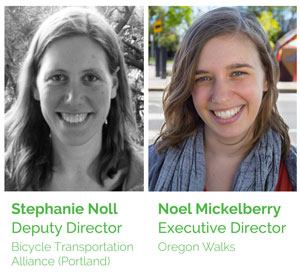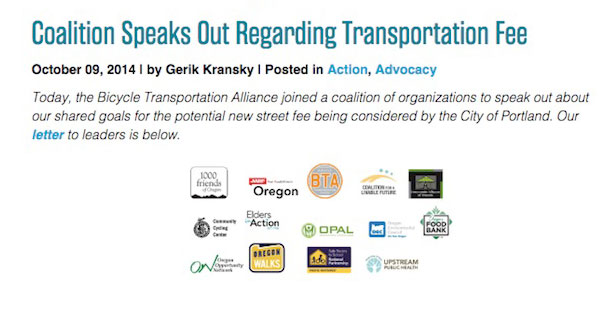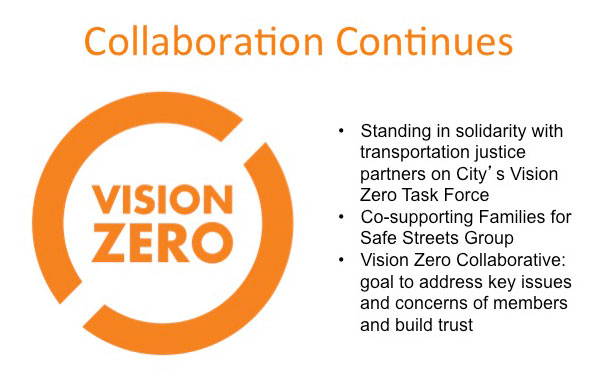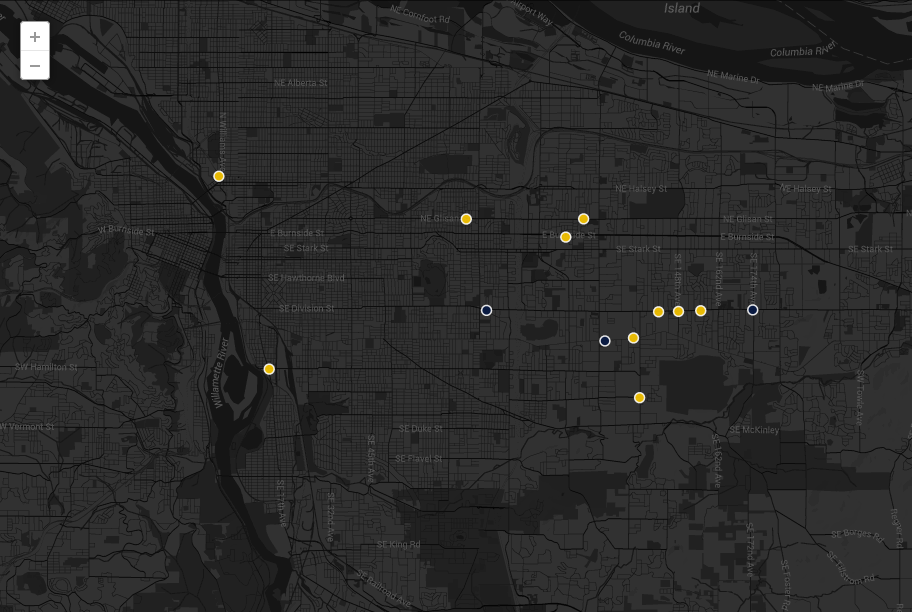 On our September Distance Learning Webinar last week, we explored leading-edge work from local advocacy organizations that are advancing Vision Zero for everyone.
On our September Distance Learning Webinar last week, we explored leading-edge work from local advocacy organizations that are advancing Vision Zero for everyone.
On Monday, we shared an overview of Vision Zero from Leah Shahum, the director of the Vision Zero Network. Yesterday, we took a look at how Walk San Francisco has partnered with public health and more than 40 community organizations to get its city leaders to adopt — and implement — safer streets for all.
And today, we explore insight from Oregon advocates who didn't just root their Vision Zero campaign in the priorities and recommendations of community partners but also grew into new equity initiatives to support their allies.
But first, a word on our co-presenters from the Northwest...
Noel Mickelberry joined Oregon Walks as Executive Director in July 2014, after being an active volunteer for more than three years and serving as Board Vice President. She has a Master of Public Administration degree with a specialization in Nonprofit Management from Portland State University, along with a Bachelor of Science in Philosophy from Oregon State University. Her previous work has been at the Nonprofit Association of Oregon, the Community Cycling Center and Outside In.
Stephanie Noll is Deputy Director of the Bicycle Transportation Alliance. She joined the BTA in 2007 as a Safe Routes to School coordinator after working in the housing justice and disability rights movements. She is leading the BTA's Vision Zero work and is deeply motivated by the vision of a community where all children (including her own) can roam freely.
(Are you an Alliance member? You can watch the full recording of the webinar — and dozens of others — in our Resource Library! Click here!)
Traffic deaths are an equity issue
For biking and walking advocates in Portland, traffic deaths were already far too high. But a watershed moment came during Valentine's Day weekend in 2014.
"Pedestrian fatalities make up a huge proportion of traffic fatalities in Portland," Noel Mickelberry, Oregon Walks' Executive Director, said. "We were feeling like something needed to happen and then, in one weekend in early 2014, two pedestrians were killed in two crashes both in East Portland."
"That part of the city was annexed in the 1980s and a lot of our high-crash corridors run through there. This is also part of the city that lacks a lot of basic safety infrastructure, like sidewalks and street lights and has long blocks with few crossings. There are significant disparities in safety infrastructure there and it's also the highest density of low-income communities, communities of color, older adults and kids."
Oregon Walks made visible the disproportionate impact of pedestrian fatalities on East Portland communities.
Over the course of two years, "10 of 13 pedestrian fatalities happened in this neighborhood, and we felt the need to do something right away," she said. "We had heard of Vision Zero as a growing movement in the U.S. and we knew our new Bureau of Transportation director had expressed interest in exploring Vision Zero. So we created a petition to bring Vision Zero to Portland."
"But, we also knew we needed to reach out to community partners in these areas and to groups that were seeing the disproportionate impact and make sure these communities saw [Vision Zero] as a priority, too. Through that process we reached out to and had 25 different organizations sign on in support of bringing Vision Zero to Portland. We delivered to every councilmember the petition with 750 signatures and the support of 25 organizational leaders who wanted to see Vision Zero as a reality here."
 Building goals from the coalition up
Building goals from the coalition up
The coalition didn't stop with the initial ask — they continued the momentum with a nuanced dive into the data.
"Six months later, we partnered with BTA to dig into where and who and how crashes were happening, so we could develop recommendations that would fit the needs of the city and our partners," Mickelberry said. "Following the research, we reached back out to each of the community groups to help develop our recommendations, to collaborate to ensure that the community priorities they saw were reflected in this report."
"We had groups that signed on originally that were extremely supportive but had concerns about how their communities see disproportionate [police] enforcement and targeting and wanted to make sure those kinds of issues were addressed in the recommendations."
Because of that, some of the issues "were different than what a lot of people might expect looking at a transportation-related report. We called for assurances against racial profiling and for communities of color and community leaders to help create those policies when it comes to Vision Zero enforcement."
"We also called for supporting legislation that allows for the issue of Driver Cards to Oregon residents who pass the test, because, at the same time we were calling for increased education for drivers, we have a huge portion of our immigrant community that's unable to get a driver's license and is left out of conversation when we're talking about ensuring drivers are safe."
"We made sure that the report built goals around what we were hearing at that table from our partners."
Standing in solidarity; redefining victory
For the Bicycle Transportation Alliance, the Vision Zero work helped to redefine their advocacy efforts to include the perspectives of new partners. One example was their stand on a proposed street fee that would have funded transportation safety projects, including for biking and walking. But, thanks to Vision Zero, their perspective... shifted.
"Thanks to the work Oregon Walks did in their initial call to action, we had more community-based partners engaged in the traffic safety conversation than ever before," Stephanie Noll, BTA's deputy director, said. "[The street fee was] the kind of issue BTA typically stood behind — advocating for more transportation funding for safety. But there were also new issues for our organization to take a stand on, in arguing for a fee that was not regressive in nature."

"We stood in solidarity with this coalition, not only on the safety issue and the amount of funding but that the fee be progressively tiered and income-based to ease the burden on low- and moderate-income households with an exemption for the lowest-income households."
"The results of that were mixed. It was a win for standing in solidarity and blocking the fee we didn’t want to see passed, but we did not successfully pass that funding source in the time we had before the state moved into legislative session and the city put its funding on the backburner to not interfere with state funding."
Broadening the boundaries of bike-ped advocacy
"During the 2015 legislative session, one of our partners launched a campaign to end profiling in enforcement," Noll added. "Because we had called out addressing profiling and disparities in enforcement in our Vision Zero report, when our partner was campaigning for this new legislation we had a strong foundation to stand on to take it to our board. Our board signs off on specific campaign endorsements if there's any question as to how it fits into our strategic plan."

"In the past, it would have been a heavy lift to support legislation not explicitly focused on transportation. But we had no problem at all gaining consensus that, of course, this was something, as an organization, we would endorse and communicate to our members and stand in solidarity with our partners on."
The measured passed.
And the collaboration between BTA, Oregon Walks and more than two dozen Vision Zero partners continues.

Learn more about BTA and Oregon Walks.


